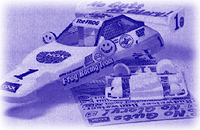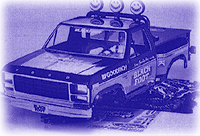Restoration of Tamiya cars
Lexan Bodies
 Lexan bodies are a tough lot. Other than cosmetics their purpose was really to protect what’s underneath the body. As such they take a lot of abuse during the normal life of an R/C car. But for some damage, there are some repairs possible.
Lexan bodies are a tough lot. Other than cosmetics their purpose was really to protect what’s underneath the body. As such they take a lot of abuse during the normal life of an R/C car. But for some damage, there are some repairs possible.
Paint that has flaked off – Okay, first thing first, try to determine whether the original paint is correct polycarbonate paint. I’ve purchased more than one used car where the previous owner used regular paint on a lexan body. As you can imagine, the paint started flaking off immediately. Painting on top of this type of finish is not going to work.
But if it is an isolated problem in one area, you can touch up a body with the correct color paint. Ensure that the surface is clean and dry prior to painting. As well, remove any loose paint in and around the area prior to painting.
Repainting an entire body – Do you really want to tackle this? First off, I’ve never found a way to remove paint from a lexan body once its been applied. Thinners tend to attack the plastic itself and any other paint remover I’ve tested with damages the lexan. Some people have suggested using automotive brake fluid, I haven't tried this yet. I’m open to ideas because the only method that has worked for me has been to use steel wool to sand the paint off... slowly... very slowly.
Cracks in the body – These can be repaired by using CA glue and attempting to glue the two edges back together. The CA is not a perfect solution as it dries into a hard substance which is no longer flexible. This fix is best for display models only. Ensure that you have clean bond prior to applying the CA. By using steel wool, attempt to rub off the paint around the affected area before applying the CA. Once it hardens you can repaint the area again. It’s important in these repairs to use as little of the CA as possible to avoid overruns or a poor surface finish.
Plastic bodies
 Restoring these are a piece of cake. Basically you’re just looking at re-painting it. The only thing you want to do is to prepare the surface properly so that the paint leaves a smooth finish. If you're wanting to remove the old paint first, you'll want to soak the body in brake fluid for a few days. This sounds crazy, but the brake fluid is perfect safe for the plastics. The problem is having to do with the expense of buying enough automotive brake fluid to soak the entire body in. Alternatively, many folks also like to use Easy-Off oven cleaner.
Restoring these are a piece of cake. Basically you’re just looking at re-painting it. The only thing you want to do is to prepare the surface properly so that the paint leaves a smooth finish. If you're wanting to remove the old paint first, you'll want to soak the body in brake fluid for a few days. This sounds crazy, but the brake fluid is perfect safe for the plastics. The problem is having to do with the expense of buying enough automotive brake fluid to soak the entire body in. Alternatively, many folks also like to use Easy-Off oven cleaner.
But first, you’re going to want to remove all of the old decals from the body and check for left over glue residue. Glue residue can be taken off with a paper towel and some WD-40. Spray a bit on the paper towel and rub the glue spot a bit. It should start to soften and can be removed from the body pretty easily.
Second, if the previous layer of paint is poor or very rough you’ll want to sand down the body a bit. Pay attention to loose or flaking paint, excessive dripping and rough finishes. If you are intent on completely removing the old coat of paint, oven-cleaners are sometimes a good choice. Products such as "Easy-Off" oven cleaner tends to be fairly effective at removing old paint and not damaging the plastic shell. I would urge caution though and test a small area prior to doing the whole body. In a well ventilated area, spray the plastic body with a liberal amount of Easy-Off (the traditional standard version) and let sit for 24 hours. Then, take the body and place under warm tap water. Scrub with a soft toothbrush and the paint should come off fairly easily. I've found that for thick coats or multiple layers, it helps to repeat this process a couple of times. What's left is a really clean body. Incidentally, you should wear latex gloves during these procedures.
Lastly you’ll want to apply a nice coat of primer and let it dry overnight. Then check for smoothness of the surface. If there are any imperfections now is the time to sand it down and fix it up.
The choice of paints is completely up to you, but I would definitely recommend the use of an airbrush as opposed to a spray can of paint. An airbrush is capable of putting out a much finer mist of paint than a spray can. This results in less paint per coat and a much smoother finish. I’ve found that spray cans tend to produce a very heavy coat of paint which dries with significant orange peel effect.
